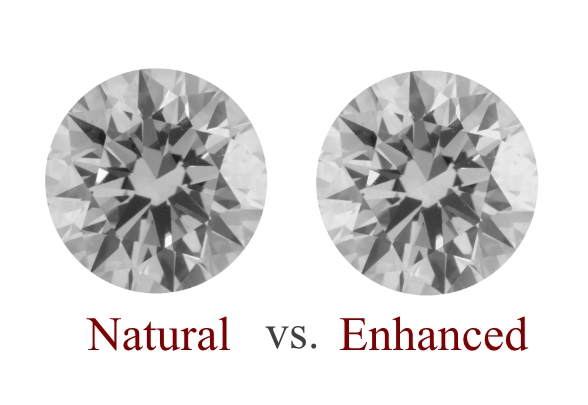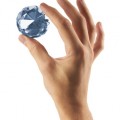If you’ve ever discussed diamonds with people working at a jewelry store, you may have heard them refer to some stones as “eye clean.” What exactly do these two words mean, and how are they related to what diamond you should buy?
“Eye Clean” Defined
The term “eye clean” is not exactly scientific, but that doesn’t keep it from being often used by jewelers.

Eye-clean diamonds have no inclusions that can be seen with the naked eye.
Basically, when a diamond is said to be eye clean, this means that there are no inclusions that can be seen in the stone when it is looked at from the top with the naked eye.
Why “Eye Clean” Is Subjective
Using “eye clean” to describe a diamond entails some problems related to how precise and robust the term’s definition is.
First, different people have different visual acuity: Some can see tiny inclusions that the average customer cannot spot; others need glasses to make out most diamond flaws.
Second, whether some inclusions can be seen depends on the light, which also affects the brilliance of the stone.
And more brilliance means fewer visible inclusions, whereas less brilliance makes flaws stand out.
As a result, whether a diamond appears eye clean varies with the kind of lighting it is exposed to.
And third, it is important from what distance you look at the diamond. The closer you get, the more likely it is that you will see an inclusion.
How to Determine Whether a Diamond Is Eye Clean
Despite the subjectivity of the definition of “eye clean,” there are some guidelines that can help you to establish whether a diamond falls into this category:
Look at the stone’s top from a distance of 8-10 inches (20-25 centimeters) with the naked eye, in broad daylight. If you wear glasses, put them on (your vision needs to be as close to 20/20 as possible).
The above conditions approximate how you and most people who come close to you will see your diamond when you are wearing it. If you cannot make out any visible inclusions such as black dots, lines or clouds, the diamond can be considered eye clean.
What Clarity Grades Are Considered Eye Clean
When it comes to matching the lower end of the “eye clean” clarity range to official clarity grades (on the G.I.A. scale), the line can be drawn at SI clarity, and more specifically SI2.
This means that any stones graded I1 and lower will not be considered eye clean, while diamonds that are SI2 and higher will look clean to the unaided eye.
Keep in mind that sometimes you may see some inclusions in SI2 diamonds even when looking from the top. Depending on the light, these flaws will usually be hard to make out without a 10x loupe, but for the most part, SI2 diamonds will appear eye clean.
Click here to take a look at real SI2 diamonds – you will probably be able to find some eye-clean ones, while others will have more visible inclusions, some even centrally located.
For this reason, SI2 clarity is considered a borderline grade: It separates the diamonds that are definitely eye clean (SI1 and above) from those that are definitely not (I1 and below).
Remember that eye clean refers only to the appearance of a diamond when looked at from the top and without magnification.
If you look at SI2-clarity diamonds from the side, you may be able to see some inclusions with the naked eye.
And if you look at an SI1 stone from the top through a microscope, you will see inclusions that you won’t be able to spot with the unaided eye.
Buying Eye-Clean Diamonds
Generally, if you want a diamond that appears clean when viewed under normal conditions, you should care more whether it is eye clean rather than obsess over its exact clarity grade.
This doesn’t mean that you shouldn’t check what the stone’s official grade is, though. Two different grades can look equally clean to the unaided eye, but the higher one may be more expensive by several thousand dollars.
If you want to make sure you don’t pay for additional clarity that you won’t be able to see, pick the lowest clarity grade that is still eye clean, i.e. in the SI1-SI2 range.
This also means that to ensure you don’t overpay for clarity, you should always ask about the exact grade of the diamond you are shown. After all, “eye clean” is not an official category, and this is why you should decide whether a diamond is worth the price asked based on clarity as certified by a reputable institution such as the G.I.A.
Lastly, buying an eye-clean SI2 stone doesn’t mean that its flaws won’t be seen from the side. If you plan on having the diamond set in a mounting that will hide its sides, that shouldn’t be a problem. However, if the side view is important to you, get an SI1 diamond.
Where to Buy Diamond Jewelry?
We recommend James Allen (read review) because you can see a 360-degree video for any diamond before buying it.
Blue Nile is another reputable diamond retailer we recommend.














